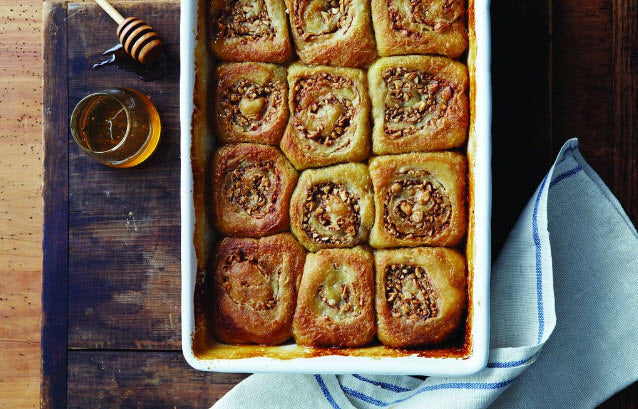
Why Honey is a Smart Alternative to Sugar (& How to Substitute)
Share

Food 52 blog by Joanne Chang
Joanne Chang—owner of Flour Bakery, author of Baking with Less Sugar, and all-around dessert wizard—has discovered that less sugar can often mean more flavor.
Today: This light and airy sticky morning bun is made entirely with honey, which means you'll keep enjoying it even after the first couple bites.
The old adage, "If it ain't broke, don't fix it" reverberated through my head as I was testing recipes for my latest book, Baking with Less Sugar. Did it really make any sense at all to create a no-sugar version of our famous sticky bun? When Bobby Flay declares your pastry "The Best Thing I Ever Ate" on the Food Network, you don't really want to mess with it. However, I was discovering how to bake with honey to make many—make that most—pastries, and I wanted to see what would happen if our sticky buns were made with the warm perfumey sweetness of honey.
Honey is one of the oldest sweeteners known to man and has been used since ancient times for medicinal and nutritional purposes. It contains trace enzymes, minerals, vitamins, and amino acids. And if you're looking to bake without refined white sugar, it's a smart alternative.

Since honey is actually a bit sweeter than sugar, you can usually reduce the amount of honey in a recipe that normally contains sugar and still have a wonderfully sweet pastry; the rule of thumb is about 20 to 25% less honey than sugar.
Here are some other points to consider when substituting in honey for sugar:
If you are using honey instead of sugar in a cookie or cake recipe that has baking powder or baking soda, you will want to add an additional 1/2 teaspoon of baking soda to the dry ingredients for every 1 cup of honey. Why? Because honey acts as an acid in baked goods and it will react with the baking soda and make your cake/cookies rise. When when you bake with sugar, on the other hand, there's no chemical reaction between the sugar and the baking soda and therefore no need to add it. (Baking soda is often in recipes that include white sugar because it reacts to otheringredients in the recipe: brown sugar, sour cream, cocoa, buttermilk, etc.).
Honey browns faster than sugar, so you’ll want to reduce the temperature of your oven by around 25° F if replacing sugar with honey.
A great attribute of both honey and sugar is that they are hygroscopic, which means they attract water and keep pastries moist. Pastries made with honey will be fresh and tender for at least a few days, if not longer.
Our original sticky bun recipe contains honey, as well as as copious amounts of brown sugar. In this recipe for Honey Cashew Morning Buns, I wanted to focus on highlighting the taste of honey (not just its sweetness) and of cashews.
Makes 12 buns
For the bun dough:
240 grams (1 cup) water, at body temperature (when you put your finger in it, it should feel neither cold nor hot)
1/2 teaspoon active dry yeast or 3 grams (0.1 ounces) fresh cake yeast
350 grams (2 1/2 cups) unbleached all-purpose flour, plus up to about 35 grams (1/4 cup) more, if needed
1 1/4 teaspoons kosher salt
50 grams (1/4 cup) olive oil or mild vegetable oil
For the honey goo:
115 grams (1/2 cup) unsalted butter
170 grams (1/2 cup) honey
120 grams (1/2 cup) heavy cream
120 grams (1/2 cup) water
1/2 teaspoon kosher salt
For the bun filling:
240 grams (2 cups) raw unsalted cashews, chopped
115 grams (1/2 cup) unsalted butter, very soft
2 tablespoons ground cinnamon
See the full recipe (and save and print it) here.
First photo by Joseph De Leo; second by James Ransom
https://food52.com/blog/13690-why-honey-is-a-smart-alternative-to-sugar-how-to-substitute
(Thank you to FOOD52 for permission to reprint this blog post by Joanne Chang, August 4, 2015.)
